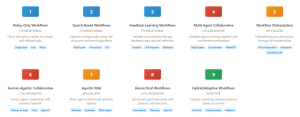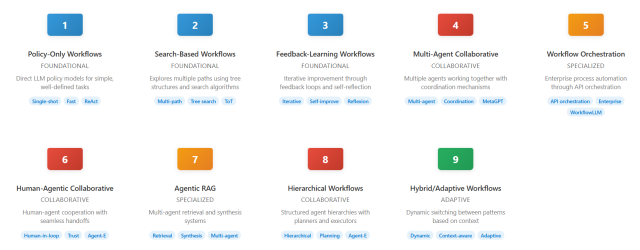
As Large Language Models (LLMs) evolve into autonomous agents, understanding agentic workflow design patterns has become essential for building robust agentic AI systems. These patterns represent proven architectural approaches that determine how AI agents coordinate, make decisions, and solve complex problems. These design patterns can be used in several use cases including enterprise automation, software development, research analysis, content creation, customer service, and process orchestration. The following nine design patterns represent foundational architectures that can be used for building agentic workflow systems. Learn from this visual animation – Agentic Workflow Design Patterns.

Policy-Only Workflows
Uses LLMs as direct policy models to generate actions or plans without search or feedback loops. Examples include ReAct for question answering and Plan-and-Solve for math problems. Simple, straightforward execution but limited exploration of alternatives. Best for well-defined tasks with clear action sequences.
References: A Survey on LLM-Based Agentic Workflows and LLM-Profiled Components – describes policy-only workflows using glm_planner and glm_actor
Search-Based Workflows
Explores multiple reasoning paths using tree/graph structures before selecting optimal solutions. Examples include Tree-of-Thoughts and RAP workflows. Uses evaluators to assess different paths and search algorithms like Monte Carlo Tree Search. Excellent for complex problem-solving requiring exploration of solution space.
References: A Survey on LLM-Based Agentic Workflows and LLM-Profiled Components – covers Tree-of-Thoughts, RAP, and Monte Carlo Tree Search workflows
Feedback-Learning Workflows
Iteratively improves responses through feedback from self-reflection, tools, environment, or humans. Examples include Reflection and Self-Refine. Incorporates learning loops where agents analyze their performance and refine future attempts. Ideal for tasks requiring continuous improvement and error correction capabilities.
References: A Survey on LLM-Based Agentic Workflows and LLM-Profiled Components – details Reflexion, Self-Refine, and CRITIC workflows with feedback mechanisms
Multi-Agent Collaborative Workflows
Multiple specialized agents work together with defined roles and coordination mechanisms (voting, debate, role-based). Includes hierarchical structures and peer-to-peer networks. Examples include MetaGPT and AgentScope. Enables complex task decomposition, parallel processing, and leveraging diverse agent capabilities for comprehensive problem-solving.
References:
- Multi-Agent Collaboration Mechanisms: A Survey of LLMs
- Large Language Model based Multi-Agents: A Survey of Progress and Challenges
- Multi-Agent Collaboration: Harnessing the Power of Intelligent LLM Agents
Workflow Orchestration/Agentic Process Automation
Automates complex business processes by orchestrating APIs and tools through LLM-driven workflow generation. Shifts from manual Robotic Process Automation to intelligent Agentic Process Automation. Examples include WorkflowLLM and AFlow. Ideal for enterprise automation, API integration, and dynamic workflow adaptation.
References:
- WorkflowLLM: Enhancing Workflow Orchestration Capability of Large Language Models
- AFlow: Automating Agentic Workflow Generation
Human-Agentic Collaborative Workflows
Combines human intelligence with agent capabilities through structured cooperation patterns. Includes human-in-the-loop modes, hybrid decision-making, and seamless handoffs between humans and agents. Requires precise specification of responsibilities and trust mechanisms. Essential for high-stakes scenarios requiring human oversight.
References:
- Towards Modeling Human-Agentic Collaborative Workflows: A BPMN Extension
- Agent-E: From Autonomous Web Navigation to Foundational Design Principles in Agentic Systems – describes human-in-the-loop modes
Agentic Retrieval-Augmented Generation (RAG)
Specialized multi-agent systems for information retrieval and synthesis. Multiple retrieval agents work in parallel, each optimized for specific data sources, while a central LLM synthesizes information. Improves accuracy, reduces hallucinations, and handles diverse knowledge bases effectively for complex queries.
References: Agentic Retrieval-Augmented Generation: A Survey on Agentic RAG
Hierarchical Agent Workflows
Organizes agents in hierarchical structures with planner agents coordinating specialized executor agents. Examples include Agent-E’s tiered architecture with planning and browser navigation layers. Enables complex task decomposition, error isolation, and specialized agent optimization while maintaining overall coordination and control.
References: Agent-E: From Autonomous Web Navigation to Foundational Design Principles in Agentic Systems – demonstrates hierarchical architecture with planner and browser navigation agents
Hybrid/Adaptive Workflows
Dynamically switches between different workflow patterns based on context, task complexity, and available resources. Combines vibe coding for creativity with agentic execution for automation. Adapts architecture in real-time, transitioning from single-agent to multi-agent configurations as needed for optimal performance.
References:
- Vibe Coding vs. Agentic Coding: Fundamentals and Practical Implications of Agentic AI
- Practical Considerations for Agentic LLM Systems
Additional Related Papers:
- Understanding the planning of LLM agents: A survey
- A Review of Prominent Paradigms for LLM-Based Agents: Tool Use, Planning, and Feedback Learning
- A Survey on LLM-based Multi-Agent System: Recent Advances and New Frontiers in Application
- Coefficient of Variation in Regression Modelling: Example - November 9, 2025
- Chunking Strategies for RAG with Examples - November 2, 2025
- RAG Pipeline: 6 Steps for Creating Naive RAG App - November 1, 2025
I found it very helpful. However the differences are not too understandable for me